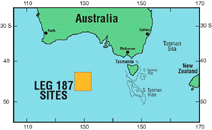ODP LEG 187: MANTLE RESERVOIRS AND MIGRATION ASSOCIATED WITH AUSTRALIAN-ANTARCTIC RIFTING
A DISCORDANCE IN EARTH'S INTERIOR
DATES: November 14 - January 9, 1999
LOCATION: Australian-Antarctic Basin, South of Australia
CO-CHIEFS: Dr. David M. Christie and Dr. Rolf-Birger Pedersen
STAFF SCIENTIST: Dr. Jay Miller
 The Ocean Drilling Program (ODP) is currently investigating one of the most perplexing segments of the global mid-ocean spreading system, located south of Australia. Spreading centers are unique locations on Earth where new ocean floor (crust) is continuously formed. Typically, spreading centers rise above the surrounding seafloor to form ridges. The seafloor in this area of study changes dramatically across short distances from smooth surfaces to very rough terrain. Scientists hypothesize that this change in seafloor terrain is actually a boundary that forms from converging pools of magma, located deep in the Earth, at the lower mantle. This narrow boundary, dubbed the Australian-Antarctic Discordance, stretches along the ridge axis between Australia and Antarctica.
The Ocean Drilling Program (ODP) is currently investigating one of the most perplexing segments of the global mid-ocean spreading system, located south of Australia. Spreading centers are unique locations on Earth where new ocean floor (crust) is continuously formed. Typically, spreading centers rise above the surrounding seafloor to form ridges. The seafloor in this area of study changes dramatically across short distances from smooth surfaces to very rough terrain. Scientists hypothesize that this change in seafloor terrain is actually a boundary that forms from converging pools of magma, located deep in the Earth, at the lower mantle. This narrow boundary, dubbed the Australian-Antarctic Discordance, stretches along the ridge axis between Australia and Antarctica.
Spreading ridges have different characteristics depending on how fast new ocean crust forms. Fast spreading ridges are associated with smooth seafloor terrain, whereas slow ones result in rough terrain. The eastern boundary of the Australian-Antarctic Discordance coincides with a seafloor morphology change from a spreading ridge with smooth topography to a spreading ridge with rough topography, suggesting influence from two separate types of spreading (slow and fast). There are also a large number of ridge-crest offset segments separated by transform faults, which indicate significant movement (north to south) among various intervals along the ridge. The Ocean Drilling Program expedition will trace the Discordance boundary at locations some distance away from the center of the ridge. This will allow the shipboard science team to determine the mantle migration history beneath the Pacific Plate over the past 30 million years and to distinguish among competing hypotheses concerning the nature and extent of mantle migration beneath this ridge system. Because lavas erupted from Indian Ocean spreading centers are chemically distinct from those of the Pacific Ocean, the shipboard scientists can "fingerprint" the origin of the rocks drilled and sampled from this region to understand the Discordance and this unusual boundary between Pacific and Indian Ocean mantle.
The two-month expedition includes a team of 13 scientists representing six countries that will be collecting samples of ocean crust. One of the physical challenges of this scientific endeavor is working in a hostile region of the world’s oceans. For centuries, mariners have known this area to be prone to extreme and dangerous sea conditions and it is commonly called the "Roaring 40’s" because of the latitude and the common occurrence of extreme winds and severe weather. The ODP’s drillship JOIDES Resolution is a very capable vessel that can work and drill in rough weather conditions. However, these conditions will result in persistent and heavy ship motion which the crew and science team will have to endure while drilling and conducting research.
ODP
The Ocean Drilling Program, an international partnership of scientific institutions and governments, explores the Earth's history and evolution. The Ocean Drilling Program is funded principally by the U.S. National Science Foundation, with substantial contributions from its international partners. These include the Federal Republic of Germany, Japan, the United Kingdom, the Australia/Canada/Chinese Taipei/Korea Consortium for Ocean Drilling, the European Science Foundation Consortium for Ocean Drilling (Belgium, Denmark, Finland, Iceland, Italy, The Netherlands, Norway, Portugal, Spain, Sweden, and Switzerland), France, and the People's Republic of China. The program is managed by Joint Oceanographic Institutions, a consortium of 14 U.S. institutions, with Texas A&M University responsible for science operations. Lamont Doherty Earth Observatory is responsible for logging services
Scientists Contacts:
David M. Christie, Co-Chief Scientist
Oregon State University
541-737-5205 -- Voice
541-737-2064 -- Fax
dchristie@oce.orst.edu
Rolf-Birger Pedersen, Co-Chief Scientist
University of Bergen (Norway)
47-555-835-17 -- Voice
47-555-894-16 -- Fax
rolf.pedersen@geol.uib.no
Jay Miller, Staff Scientist
Ocean Drilling Program
409-845-2197 -- Voice
409-845-0876 -- Fax
jay_miller@odp.tamu.edu
Ship's email address:
jrs_firstname_lastname@odp.tamu.edu
Example: jrs_david_christie@odp.tamu.edu
